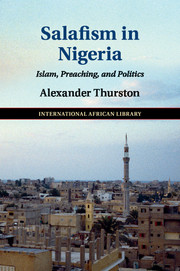Book contents
- Frontmatter
- Contents
- Acknowledgments
- List of Maps
- Introduction: Defining Salafism, Analyzing Canons
- Part I Salafism and Its Transmission
- Part II The Canon in Action
- Part III Boko Haram and the Canon
- 7 Boko Haram from Salafism to Jihadism
- 8 Reclaiming the Canon
- Conclusion
- Appendix 1 The Sermon of Necessity (Khuṭbat al-Ḥāja)
- Glossary of Persons
- Glossary of Arabic Terms
- Bibliography
- Index
- Miscellaneous Endmatter
7 - Boko Haram from Salafism to Jihadism
from Part III - Boko Haram and the Canon
Published online by Cambridge University Press: 05 September 2016
- Frontmatter
- Contents
- Acknowledgments
- List of Maps
- Introduction: Defining Salafism, Analyzing Canons
- Part I Salafism and Its Transmission
- Part II The Canon in Action
- Part III Boko Haram and the Canon
- 7 Boko Haram from Salafism to Jihadism
- 8 Reclaiming the Canon
- Conclusion
- Appendix 1 The Sermon of Necessity (Khuṭbat al-Ḥāja)
- Glossary of Persons
- Glossary of Arabic Terms
- Bibliography
- Index
- Miscellaneous Endmatter
Summary
The most infamous outgrowth of Nigerian Salafism is the violent movement Ahl al-Sunna li-l-Daʿwa wa-l-Jihād (Salafis for Proselytisation and Jihad), better known by its Hausa nickname Boko Haram (Western Education Is Forbidden by Islam). In March 2015, Boko Haram reinforced its infamy by swearing allegiance to Al-Dawla al-Islāmiyya fī al-ʿIrāq wa-l-Shām (the Islamic State in Iraq and Syria, ISIS), a jihadi army and proto-state that blossomed amid the ashes of post-Saddam Hussein Iraq and war-torn Syria. Given its local roots and global affiliations, what is the relationship between Salafism and jihadism for Boko Haram? What light does this case shed on the trajectory of so-called Salafi-jihadism worldwide?
Boko Haram's founder Muḥammad Yūsuf (1970–2009) was a Salafi rooted in the broader landscape of northern Nigerian Salafism. In his June 2009 “Open Letter to the Federal Government of Nigeria” – one of the last lectures Yūsuf delivered before Boko Haram launched an ill-fated but consequential uprising the following month – his rhetorical debt to Jaʿfar Ādam was clear. Yūsuf was not a graduate of the Islamic University of Medina, but he rose to prominence as a member of the Salafi networks around the Medina graduates and he had been a protégé of Ādam. By 2009, Yūsuf's break with Ādam was complete: they had denounced each other publicly, and Ādam had been assassinated – perhaps by Yūsuf's followers – in 2007. But Yūsuf continued to draw on styles the Medina graduates had honed. In his June 2009 lecture, he began with the Sermon of Necessity and then, like Ādam had done in many of his lectures, launched into a methodical but free-flowing polemic against the political authorities. Unlike Ādam, however, Yūsuf exhorted his audience not just to criticize and correct the authorities, but to confront them.
Drawing on Yūsuf's manifesto and Boko Haram's propaganda videos, this chapter argues that Boko Harm first narrowed and then later deemphasized the Salafi canon. Boko Haram frequently invoked the Salafi canon during its phase of open preaching from 2002 to 2009. Yūsuf sought canonical legitimation for his most famous stances, his rejection of Western-style schools and his denunciation of secular government, as well as for his underlying framework of religious exclusivism.
- Type
- Chapter
- Information
- Salafism in NigeriaIslam, Preaching, and Politics, pp. 193 - 219Publisher: Cambridge University PressPrint publication year: 2016

